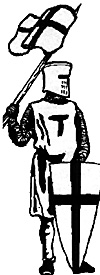 (This is a battle report from a historical medieval wargame held by the Mid-Ohio
Gamers' Group [M.O.G.G.] last June.)
(This is a battle report from a historical medieval wargame held by the Mid-Ohio
Gamers' Group [M.O.G.G.] last June.)
The Battle of Leignitz was fought on April 9, 1241. Legnica, as the city is known today, is located in southwestern Poland in the province of Silesia, not far from the city of Posin. The European army of Poles, Hungarians, Prussians and Frenchmen fought a smaller Mongol army.
We had 13 players using modified Chainmail rules. The commanders on the Mongol side were: Greater Generals Kadan (me) and Baidar; The Captains Orlock, Noyan, Batu and Bahadur. The commanders on the European side were: Generals Prince Henry of Silesia and Duke Miecislaw; Captains Sudislaw, Boleslaw Syepiolka of Moravia, Poppo von Osterna. of the Teutonic Knights Prussian Landmeister, the peasant commander of Posen and the knight commander of Posen.
The Mongol light horse advanced in open order and fired arrows on all fronts*. The Polish knights and Poppo von Osterna with his Teutonic knights charged in the center. The Mongol light horse fired and retired before the advancing Poles. Then the Mongol heavy horse fired twice and killed the majority of the Polish knights. The Mongol catapults tossed "flash-bang pots" and broke the charge of the Teutonic knights and routed them.
The left and right flanks arched arrows and retired from the Poles and Hungarians. The right flank of the Mongols formed two giant spinning Scythian wheels. The Polish staffslingers were a nasty surprise to the Mongol light horse, though. Before long, the Polish center reformed and the Teutonic knights charged the light and heavy Mongols, who fired arrows at them. Once again, the catapults loosed the "flash-bang pots" and broke the charge. Meanwhile, the Mongol left and right flank gave ground again, exchanging arrow fire with the Poles. The Mongol left flank received heavy horse reinforcements just in time to avoid being outflanked by the Hungarians of Boleslaw Syepiolka. The reinforcements hotly engaged the Hungarians, holding them up while the catapults broke the advance of the Poles on that flank.
The right flank of the Mongols exchanged heavy archer fire with the Europeans. Each side took lots of hits. Troops arriving late to the battle reinforced each side. Cavalry and infantry bolstered the Mongols right, while the foot knights and men-at-arms of Posen reinforced the Polish left.
In the center, a large peasant rabble from Posen joined Prince Henry and the remaining Poles, raising the hopes of the Europeans. The prince promised "Land & Livestock" to the peasants, who eagerly joined the battle. Then the Mongol General Kadan committed all heavy reserves to the center. Rallied by the peasant reinforcement, the remaining Teutonic Knights led by Poppo von Csterna charged. The knights took heavy hits from the Mongol archery and catapults, but weathered the fierce fire. The heavy Mongols countercharged and met the Teutonic Knights in combat. The lighter Mongols charged the Polish staff slingers and peasants of Posen. Poppo von Osterna and his knights died to a man and the peasants were routed.
The Mongol left flank held the line by the skin of their teeth -- barely stopping the outflanking Hungarians. The Mongol right flank also stopped giving ground and attacked the Polish infantry, who in spite of heavy casualties, held fast. The Polish infantry tried to support the center, but the Mongols slipped past them to attack Prince Henry. However, the peasants of Posen rallied and charged to save him. The prince quickly withdrew from the fight, struck by arrows from Kadan's unit (causing two out of his four hits) as he ran off the field. This caused the Polish center to collapse, allowing the Mongols to cuff lank the forces of Duke Miecislaw and Sudislaw. The duke was attacked and his cavalry guard slain, but he was saved by his infantry. When the European center collapsed, Baidar was able to relieve the Mongol left flank that Boleslaw Syepiolka of Moravia had nearly ouff lanked and was pressing hard.
This led to a decisive Mongol victory and the game was called after five hours of play. All players agreed the seesaw battle was a fun way to close the M.O.G.G. gaming season.
Back to The Herald 27 Table of Contents
Back to The Herald List of Issues
Back to MagWeb Master Magazine List
© Copyright 1999 by HMGS-GL.
This article appears in MagWeb (Magazine Web) on the Internet World Wide Web. Other military history articles and gaming articles are available at http://www.magweb.com